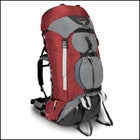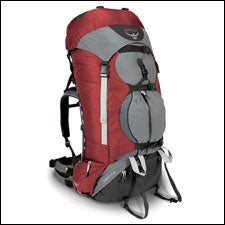One word: Big. Not huge, but good-sized. Something in the 4,500- to 5,500-cubic-inch range, although frugal packing might mean you can get by with less. Another word is: Fit. Packs are like shoesthey have to fit well, or youll be miserable. And that misery will last a very long time. As in 2,160 miles worth of walking.
 Osprey Crescent 85
Osprey Crescent 85So, which pack? I would say there are four absolutely solid choices:
ArcTeryx Bora 80 ($369; www.arcteryx.com): An excellent packsuperb suspension, good design that makes the entire pack easily accessible, handy touches such as an outside pocket that drains when your gear gets wet. It also has a hydration sleeve and lots of outside attachment points. Carries 4,700 cubic inches in size medium, which should be fine, depending on how much food you intend to carry at a stretch.
Gregory Whitney ($329; www.gregorypacks.com): If your taste or needs run to larger packs, consider the Whitney. A wonderful backpacking pack, which, like the Bora, combines top- and side-loading features for easy access. Gregory always has made excellent suspensions, and the Whitney has that with a partial framesheet, V” stays that carry the load to your hips, and adjustable belt and shoulder straps. With 5,450 cubic inches of capacity in size medium, its a big pack.
Osprey Crescent 85 ($379; www.ospreypacks.com): A big (5,300 cubic inches in large), well-designed pack with an interesting twist: Its waist belt can be heat-molded for a custom fit. Osprey packs carry beautifully even without that feature, plus the Crescent has a built-in hydration pouch, a waterproof compartment for things that must stay dry (or for very wet things that must be isolated), and easy access to nearly all of the pack.
Dana Design Terraplane LTW ($369; www.danadesign.com): The Terraplane has been the classic big pack for I dont know how many years. The newest version, the LTW, uses tough but lighter materials to trim about a pound from its weight. Its a big (5,800 cubic inches) pack, but one that makes 50-pound loads seem manageable. Ive always liked the two big back pockets on the Terraplane, which can swallow up just about every piece of gear youre apt to need quickly during a day.
So there you go. There are good, less-expensive packs as well, such as Keltys Redcloud ($175; www.kelty.com), a fine, big pack (5,600 cubic inches) that can manage a trek like the Appalachian Trail. And if you can trim your load, then Mountainsmiths lightweight,4,000 -cubic-ince Auspex ($199; www.mountainsmith.com) is a good choice. And then theres the whole ultralight concept, pioneered by Ray Jardine. The philosophy has a dedicated following (check out www.backpacking.net for more info), but heading in that direction may require you to rethink a whole mess of options, like swapping your camp stove for a homemade cooker crafted out of an empty beer can.
Try on several packs, though, to be sure you have one that suits you. And have a great hike!


